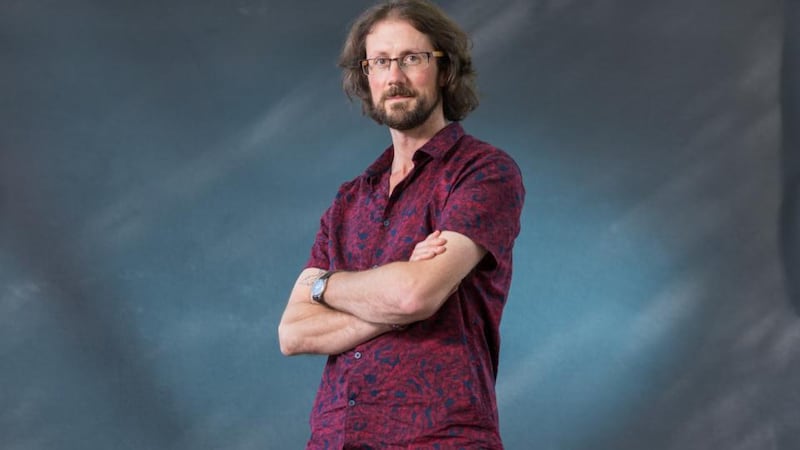In a Sand County Almanac, the great American ecologist Aldo Leopold wrote "one of the penalties of an ecological education is that one lives alone in a world of wounds". John Kinsella's new collection The Wound (Arc Publications) scrutinises this notion in all of its personal, political and artistic implications. This is achieved by means of a binary arrangement of material: in the first section of the book the poet adopts the mask of Mad King Sweeney, and second part is comprised of loose translations from Hölderlin.
The short introduction describes the collection as “two short books in conversation with each other, making a single but pluralistic response to the violence being enacted by humans on humans, and on the natural environment”. Rather than confine his wanderings to these islands, Kinsella’s Sweeney takes in the whole wounded planet on his flight path.
This is a striking feature of Kinsella’s highly political poetry: while it is concerned with what Kavanagh termed the “local row” (the link between indigenous land rights and neo-colonial rapine in Australia, for instance), it also takes a globalised view of these matters, so that the poems’ perspective never rests either on the particular or the abstract, but shifts constantly between the two.
Ambition and passion
The ambition and passion of this poetry is unmistakeable, but even the most politically sympathetic reader can occasionally feel out of temper with the didacticism of much of the work, which can feel like reading a polemic on the depredations of global capitalism rather than a collection of poetry: “There’s no denying the truth – /the ‘sacrifice’ of animals to human/addiction and thanatos. This omnicultural/worshipping of death to affirm life”.
The anger and outrage are justified and palpable, and it is possible to combine sorrow and outrage with great writing – as writers like Annie Dillard, Robinson Jeffers, or JA Baker have demonstrated – it’s just extremely difficult to do it memorably or convincingly. Either the outrage overbalances and clutters up the poetry, or there is a risk of mere hand-wringing. The poems of the collection’s second section, “After Hölderlin”, are more seductive, perhaps because they have crystallised around the armature of the German poet’s highly suggestive and original language.
There is a powerful translation of Geh Unter, Schöne Sonne and several versions of Hälfte des Lebens that do the poet's job of focusing on sensuous particulars rather than bashing the reader over the head with righteous wrath: "O, what reveals/ Winter's grasp, the blossoms, and also/the sunbursts/and dirt shadows?"
In a more general sense, The Wound highlights a central issue with political poetry; whether one feels, with Auden, that "poetry makes nothing happen" despite the poet's possession of "a voice/to undo the folded lie"; or whether one believes, in accordance with Kinsella's biographical note, that "poetry is one of the most effective activist modes of expression and resistance we have".

Anthropogenic destruction
The poems of Paul Kingsnorth's Songs from the Blue River (Salmon Poetry) contrast interestingly with Kinsella's, as they also represent frontline witness of anthropogenic destruction. An author's note tells us that "many of the poems in this collection were written more than half a decade ago in Chilean Patagonia", when the poet witnessed the protests surrounding the government's scheme to dam the Baker and Pascua rivers, an event which, largely due to public pressure, did not in the end happen.
As well as his environmental activism, Kingsnorth is also a critically acclaimed novelist, a writer of non-fiction, and a founder of the Dark Mountain Project, which is a network of ecologically minded artists and writers, a compelling example of Kinsella’s belief that the arts matter in the face of the coming crisis. The Dark Mountain Project is a systematic attempt to bear witness to the fact that (as their manifesto puts it) “there is a fall coming”. Kingsnorth’s poems, influenced by DH Lawrence, Robinson Jeffers, RS Thomas, and Ted Hughes, also do this.
Alert to beauty
They are not interested in piling up evidence (after all, the reader is smart enough to draw her or his own conclusions); instead this is the lyric poet as true witness, not just of the "wounds" of ecocide, but of (as Stevens put it) "what we felt at what we saw". This voice is convincing; Kingsnorth's is a unified sensibility, alert to beauty, immersed in particularity: "it came and sang in me in winter/when the light was low/and I was in the black fields/with frost across my shins/and the stubble of the corn gone white". Inquisition, the penultimate poem in the collection, is a striking statement of the dilemma of the lyric poet in the face of all this horror, when the unquenchable instinct is still to be a celebrant, a praise-singer.
The speaker of this poem, with a nod to Ginsberg and Arnold, says, "I saw the villages sucked dead like flies/ . . . I heard the long withdrawing roar,/the grating of pebbles, watched the lights wink out in the souls of Men and on in the deserts./ Would you like me to write love poems?" And his visionary interlocutor replies: "I would like you to write love poems which settle/in the hearts of women and men who see what you see/and live with it." What is evident from both Songs from the Blue River and The Wound is that both Kingsnorth's and Kinsella's protean and multifaceted voices are important ones to listen to in these times.











